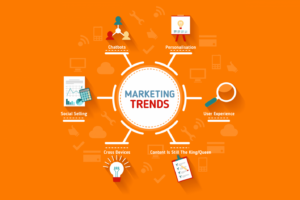Peter Sondergaard, a renowned analyst, said, “Information is the oil of the 21st century, and analytics is the combustion engine.” To achieve optimal success in the marketing field, data-driven analysis and reporting, including predictive analytics in marketing campaigns, are considered pivotal in several aspects, such as defining and achieving objectives, identifying patterns and trends, and developing strategies.
In the modern era, handling, analyzing, and disseminating information is important for a digital marketing firm. After the use of manual files and computer systems, programmers and other tech individuals have developed result-oriented solutions, such as high-capacity drives (in terabytes), cloud computing, CRM systems, and artificial intelligence.
Concerning AI, the standards of data assimilation and dissemination have increased substantially. Organizations have adopted a centralized approach toward strategy building, customer-driven marketing, and brand loyalty. Moreover, unprecedented insights and solutions have provided a wide platform for digital marketers to work on. The use of predictive analytics has become a mandatory aspect in every sector.
What is Predictive Analytics?
The process of forecasting outcomes by analyzing and interpreting historical data, statistical algorithms, and machine learning techniques. Insights are extracted from large data sets to identify patterns of individuals purchasing, browsing the Internet, spending time on SM, and more. For example, if we consider travel, predictive analytics can be used to analyze air traffic routes to estimate delays and congestion. This information can then be applied to modify strategies accordingly.
Predictive AI Analytics for Marketing Campaigns – A Novel Approach
The conversion of gargantuan data into actionable outcomes is the most modern technique of digital marketers to develop strategies and plans. Predictive AI enhances the quality of targeting, segmentation, and promotion effects. Moreover, it helps to detect fraud, reduce risks, and improve operations.
1. Predict Consumer Trends
When it comes to selecting the right product or service, customers tend to muse for several minutes or hours before finalizing. In this regard, the buying process trend is not easy to comprehend. But, with the advent of predictive analytics, marketers have gained a distinctive edge in spotting emerging patterns.
For example, a new fashion style, such as bellbottom gains the limelight after consumers start purchasing. AI analyzes the entire process, from online shop locations to purchases per hour, offering a wide scope for salespersons to develop a marketing campaigns strategy.
2. Refine Customer Segmentation
In the example above, artificial intelligence algorithms can segregate and provide a tailored customer segment that purchases the highest quantity of bellbottoms from a specific locality, town, or city. Moreover, it can also depict the demographics of customers across the entire research platform; their age, gender, cell number, and other aspects.
Segregated data is essential for marketers to develop a clear-cut marketing plan. With pertinent information, they can choose and pick the right information to create personalized campaigns.
3. Reduce Customer Churn
Attracting new customers is a higher-cost process than retaining present ones. Predictive AI can analyze trends in customer downturns with regard to buying specific products or using services. Moreover, it can relate to the underlying problems of customers disengaging with a brand or business. Those who are liable to churn, are identified and placed in a reconnecting program that provides tailored experiences.
Predictive Analytics Models
Models are the foundation of predictive AI. These templates are used by marketers to convert data into actionable strategies.
- Customer Lifetime Value Model
- Customer Segmentation Model
- Predictive Maintenance Model
- Quality Assurance Model
So, what is your opinion? Is predictive analytics the right choice for your brand or business?









